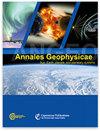日侧磁层中的次风暴特征
IF 1.9
4区 地球科学
Q3 ASTRONOMY & ASTROPHYSICS
引用次数: 0
摘要
摘要我们研究了磁层顶位置随行星际磁场(IMF)和磁层亚暴不同阶段而发生的变化。我们利用多颗卫星(THEMIS、RBSP和MMS)的磁场观测数据,以及利用OMNI太阳风数据建立的Shue模型,研究了2016-2020年五年间磁层顶的平均位置。我们通过对不同亚暴时间(开始、高峰和结束)的对峙距离和尾焰角的叠加历时分析,以及通过对 IMF |Bz|> 0 条件下平均 Δ BZ 的二维赤道地图的现场测量,利用 Shue 模型估计了磁极的平均位置。我们的发现揭示了在 IMF 向北和向南的方向上都会发生亚暴,并强调了在亚暴开始和高峰期间磁层顶会向地球移动,随后在亚暴结束期间,IMF 向北和向南的方向都会出现松弛。值得注意的是,在强南向 IMF(BZ <-5)的情况下,特别是在亚暴高峰期,磁层顶会发生明显的压缩,并达到与地球的最近点。由于模型曲线穿越了一个明显的位置(Δ BZ = 0),代表了Δ BZ 的二维平均图中显示的磁极点,因此经验模型可以准确估计出强向北和强向南 IMF |Bz|>5期间的磁极点位置。本文章由计算机程序翻译,如有差异,请以英文原文为准。
Substorm Signatures in the Dayside Magnetosphere
Abstract. We investigate variations in the position of the magnetopause in response to the interplanetary magnetic field (IMF), and different phases of magnetospheric substorms. The average location of magnetopause is examined using magnetic field observations from multiple satellites (THEMIS, RBSP, and MMS), and the Shue model utilizing OMNI solar wind data for a period of five years from 2016–2020. We estimate average position of the magnetopause using Shue model through superposed epoch analysis of standoff distance and tail flaring angle at different substorm timings (onset, peak and end) and from in-situ measurements through 2D equatorial maps of average Δ BZ under IMF |Bz|> 0 conditions. Our findings reveal the occurrence of substorms during both northward and southward IMF orientations and highlight an earthward movement of the magnetopause during substorm onset and peak, followed by a relaxation during the substorm end time, for both northward and southward IMF orientations. Notably, the magnetopause undergoes significant compression and reaches its closest point to the Earth during instances of strong southward IMF (BZ < -5), particularly during the substorm peak. The empirical model provides accurate estimation of the magnetopause location during periods of both strong northward and southward IMF |Bz|>5, as the model curve traverses a distinct location (Δ BZ = 0) representing the magnetopause shown in the 2D average map of Δ BZ.
求助全文
通过发布文献求助,成功后即可免费获取论文全文。
去求助
来源期刊

Annales Geophysicae
地学-地球科学综合
CiteScore
4.30
自引率
0.00%
发文量
42
审稿时长
2 months
期刊介绍:
Annales Geophysicae (ANGEO) is a not-for-profit international multi- and inter-disciplinary scientific open-access journal in the field of solar–terrestrial and planetary sciences. ANGEO publishes original articles and short communications (letters) on research of the Sun–Earth system, including the science of space weather, solar–terrestrial plasma physics, the Earth''s ionosphere and atmosphere, the magnetosphere, and the study of planets and planetary systems, the interaction between the different spheres of a planet, and the interaction across the planetary system. Topics range from space weathering, planetary magnetic field, and planetary interior and surface dynamics to the formation and evolution of planetary systems.
 求助内容:
求助内容: 应助结果提醒方式:
应助结果提醒方式:


